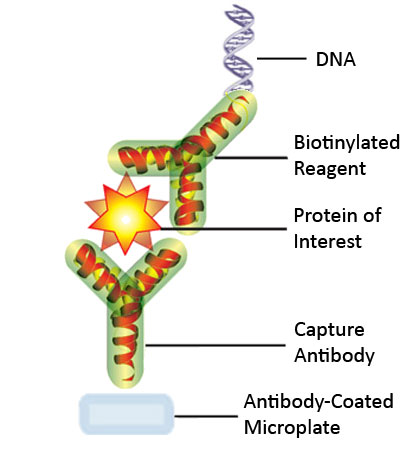RayBiotech has just announced the release of a new ELISA test technology breakthrough that I am quite thrilled to share with you. If you have precious samples with low abundant target and which require high sensitivity, then this post will be of interest to you!
The RayBio® Immuno-Quantitative ELISA (IQELISA) kit is an innovative assay platform that combines the specificity and ease of use of a sandwich ELISA test with the sensitivity of real-time PCR. This results in an assay that is cutting edge and yet familiar, enabling the use of only 1/10th of the typical sample volume while providing up to 10x more sensitivity than a traditional ELISA test. The IQELISA technology is completely novel, patent pending, and has no equivalent in the market at this time.
The IQ ELISA features a sandwich-based format, in which the capture antibody is coated on a 96-well PCR strip plate. Standards, samples, and detection antibody are added and washed off as usual – however, instead of HRP streptavidin, primers and PCR master mix are added to each well. Signal development occurs with your quantitative PCR instrument for cycling and measurement of DNA amplification. The Ct values are inversely proportional to the amount of captured antigen bound to each well.
The kit is compatible with any qPCR instrument that accepts low-profile plates, either skirted or non-skirted.
Main IQ ELISA test features
• 10x more sensitive than ELISA
• Use as little as 10µl per sample
• Excellent for follow up/confirmation of antibody array data
• Pre-coated 96 well plate, non-skirted PCR plate
• Tear away strip plate format minimizes waste
• Compatible with most qPCR machines
• Complete kit includes all necessary reagents
• Reproducible and reliable
• Optimized for serum, plasma, urine and cell culture medium
How does the IQ ELISA test work?

RayBio® IQELISAs employ specific capture antibodies coated on a 96-well PCR plate. Standards and samples are pipetted into the wells; the target protein in the standards and samples binds to the immobilized antibody. The wells are washed and the detection affinity reagent is added to the wells where it binds to any captured antigen. The wells are washed again, and primers and PCR master mix are added to each well. The plate is placed into a real time PCR instrument for cycling and measurement of DNA amplification. The cycle number where amplification is detected is proportional to the amount of affinity detection reagent that bound to captured antigen in each well.
4 IQELISA tests have just been released: Human VEGF, IFN-gamma, PDGF-BB, and HGFR… but the analyte list will be expanded in a very near future.
Would you like to be informed about new releases, or do you have any questions about this new ELISA test technology?
Leave your comments and questions below, I’ll be pleased to get back to you and keep you updated on the next IQELISAs when as soon as they are available.




3 Responses
I am looking for a kit which would quantitatively measure Human Soluble TNF Receptor (sTNFr1 & sTNFR2) in serum &plasma.
Dear Khalid,
Thank you very much for your question on this post.
The following ELISA may suit your need: ELH-TNFR1-1 and ELH-TNFR2-1. The datasheets are available at the above links to give you access to sensitivity and range data for each of them.
You can get in touch with our German office at this address should you wish to contact them for a quote.
I remain available for any further question.
Kind regards,
Isabelle
Hello Isabelle,
your swift reply is highly appreciated. I will contact directly the German office for a quote.
Thanks and Regards
Khalid